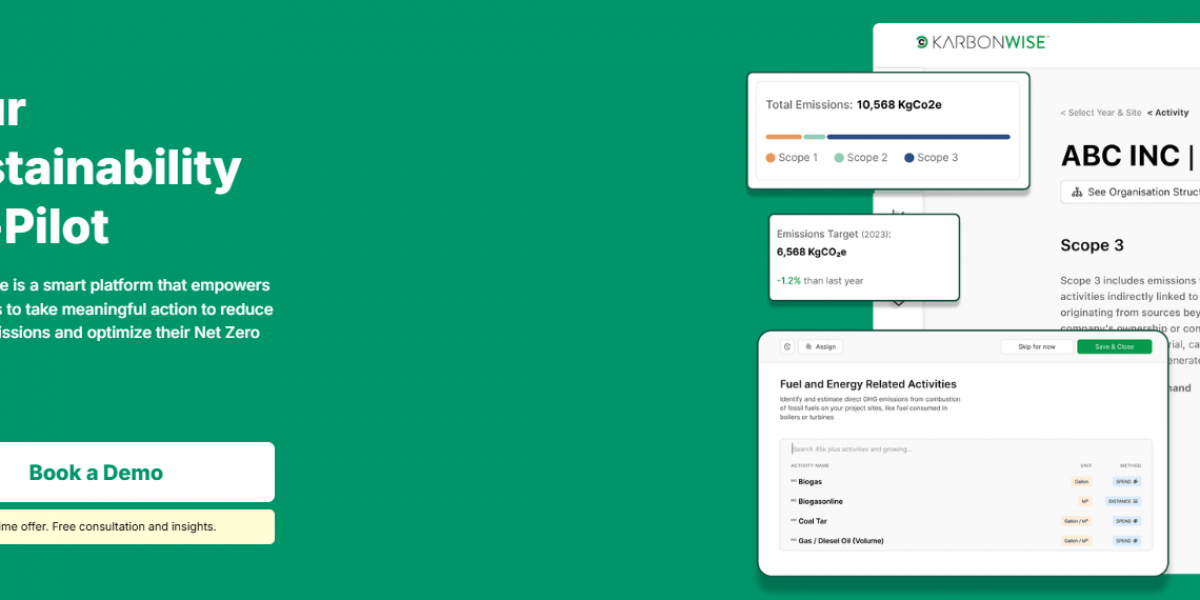In the era of heightened environmental awareness, businesses are increasingly held accountable for their carbon footprints. While many companies focus on Scope 1 and Scope 2 emissions—those generated directly from their own operations—Scope 3 emissions often represent the largest and most challenging portion of their environmental impact. These emissions, which occur throughout the entire value chain, are not directly under a company’s control but play a significant role in achieving long-term sustainability. This blog will explore what Scope 3 emissions are, why they matter, and how businesses like KarbonWise can manage and reduce them for a greener future.
What Are Scope 3 Emissions?
The Greenhouse Gas (GHG) Protocol outlines three categories of emissions, known as scopes:
- Scope 1: Direct emissions from owned or controlled sources, such as company vehicles, buildings, or manufacturing facilities.
- Scope 2: Indirect emissions from the generation of purchased electricity that a company consumes.
- Scope 3: All other indirect emissions that occur throughout a company’s value chain, both upstream and downstream.
Scope 3 emissions are the most expansive and diverse category. They can stem from various sources, including the extraction and production of purchased goods and services, business travel, employee commuting, waste disposal, and the use and end-of-life disposal of products sold by the company.
For instance, a company manufacturing a consumer product may have minimal direct emissions (Scope 1) but a significant environmental impact from the raw materials used in its production, the energy consumed during its transportation, and the carbon footprint generated by consumers using or disposing of the product. Thus, Scope 3 emissions encompass everything that happens outside the direct operational control of the business but is still tied to its activities.
Why Are Scope 3 Emissions Important?
- They Represent the Majority of a Company’s Emissions
For many businesses, especially those with complex supply chains or consumer-facing products, Scope 3 emissions can account for up to 70% or more of their overall carbon footprint. For example, large retailers, tech companies, and food producers often find that their Scope 3 emissions vastly exceed their Scope 1 and Scope 2 emissions combined. Ignoring these emissions means overlooking a significant source of environmental impact.
- Increased Regulatory Demands and Reporting Requirements
As governments and regulatory bodies around the world intensify their focus on climate change, businesses are increasingly being asked to report not just on direct emissions, but also on their broader environmental impact. The Corporate Sustainability Reporting Directive (CSRD), for instance, is a European Union regulation that mandates companies to disclose their sustainability efforts, including Scope 3 emissions. Similarly, frameworks like the Task Force on Climate-related Financial Disclosures (TCFD) encourage companies to measure and report on their full environmental footprint, including supply chain emissions.
For businesses aiming to stay ahead of regulatory pressures, managing Scope 3 emissions is no longer optional. Comprehensive reporting can also enhance transparency, build consumer trust, and attract investors focused on sustainable practices.
- Consumer Expectations and Competitive Advantage
With more consumers demanding transparency regarding the sustainability practices of the brands they support, businesses must recognize that Scope 3 emissions play a crucial role in shaping public perception. Companies with high Scope 3 emissions that are not taking action to reduce them may find themselves facing reputational risks, as customers increasingly choose eco-conscious brands. Reducing Scope 3 emissions provides an opportunity to align with these growing consumer expectations.
Incorporating sustainability into every aspect of the value chain can also differentiate companies in a competitive market. Businesses that proactively manage their Scope 3 emissions are seen as leaders in corporate responsibility, which can result in stronger customer loyalty and a better market position.
- Cost Savings and Risk Mitigation
Addressing Scope 3 emissions can also bring about significant cost savings and risk reduction. By optimizing supply chains to reduce emissions, companies can uncover efficiencies that lower operational costs. For instance, working with suppliers to use less energy-intensive processes or improving logistics to minimize transportation emissions can reduce both emissions and expenses.
Moreover, taking proactive steps to reduce Scope 3 emissions helps mitigate future risks, such as supply chain disruptions due to environmental regulations or the loss of market share from customers increasingly concerned with sustainability. Companies that ignore Scope 3 emissions may find themselves facing higher costs or even market exclusion in the long run.
How to Manage Scope 3 Emissions
Managing Scope 3 emissions is complex, as it involves working across a company’s entire value chain, from suppliers to consumers. However, with the right strategies in place, businesses can make significant strides in reducing these emissions. Below are several key steps companies like KarbonWise can take:
- Measure and Monitor Scope 3 Emissions
The first step in managing Scope 3 emissions is to gain a clear understanding of where they come from. This involves identifying and measuring emissions from key sources within the value chain. Companies need to collaborate with suppliers, customers, and other stakeholders to gather data and calculate emissions associated with various activities, such as manufacturing, transportation, and product use.
Using tools like carbon accounting software or collaborating with third-party sustainability experts can help track and report emissions more accurately.
- Engage with Suppliers and Partners
Since much of Scope 3 emissions arise from the supply chain, it’s essential for companies to engage with suppliers to reduce their emissions. This can include collaborating with suppliers to adopt sustainable practices such as using renewable energy, improving energy efficiency, and reducing waste. For businesses like KarbonWise, working with supply chain partners to improve sustainability throughout the value chain is key to reducing overall Scope 3 emissions.
- Optimize Product Design and Lifespan
Product design can have a substantial impact on Scope 3 emissions, particularly during the product’s use and disposal phases. Designing products that are energy-efficient, made with sustainable materials, and recyclable can significantly reduce emissions. Additionally, companies can encourage customers to use products in a more sustainable way and offer take-back programs to reduce waste.
- Promote Sustainable Consumer Behavior
Encouraging customers to reduce their environmental impact can help lower emissions linked to product use and disposal. Companies can educate consumers on how to extend the lifespan of products, reduce energy consumption, or recycle at the end of the product’s life. Additionally, offering more sustainable alternatives can incentivize consumers to make eco-friendly choices.
- Set Emission Reduction Targets and Track Progress
As with any sustainability initiative, setting clear and measurable goals is critical. Companies should establish specific targets for reducing Scope 3 emissions and track their progress over time. This may include setting annual reduction targets, identifying areas for improvement, and implementing programs to drive change across the value chain.
Conclusion
Managing Scope 3 emissions is essential for any business committed to sustainability and climate action. By understanding where these emissions come from, setting clear targets, and engaging with suppliers and customers, companies like KarbonWise can reduce their carbon footprint and make meaningful progress toward a more sustainable future. Reducing Scope 3 emissions not only helps mitigate environmental impact but also positions companies as leaders in an increasingly eco-conscious market, ensuring long-term success and regulatory compliance.








